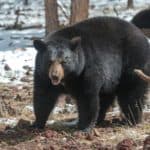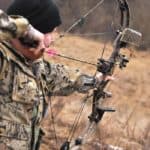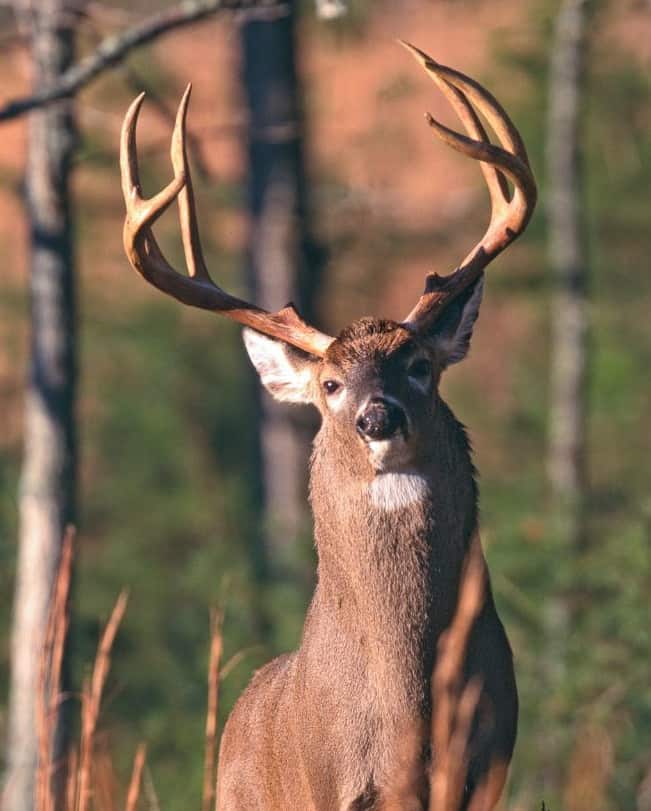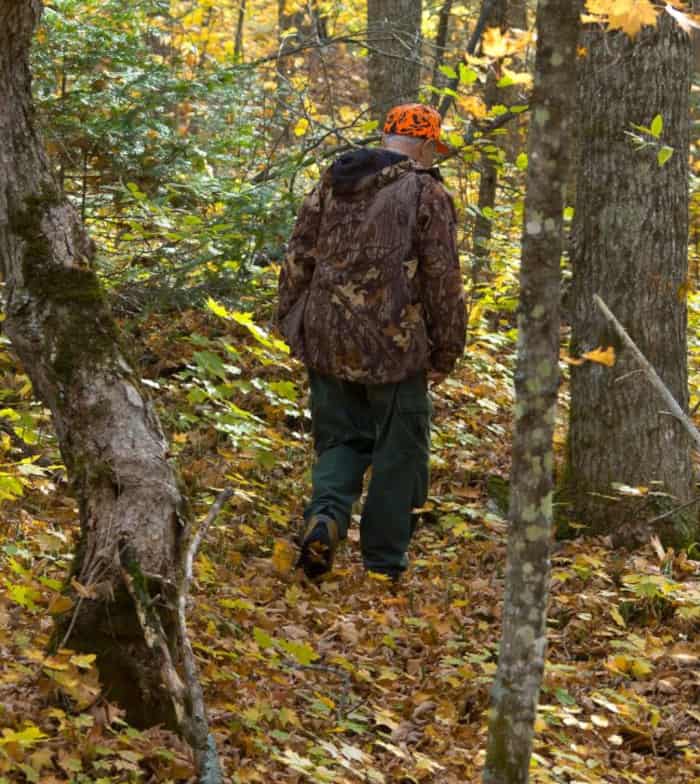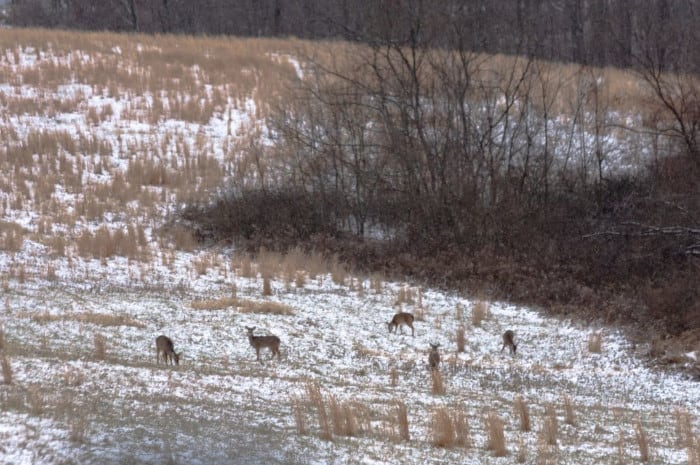Ask any deer hunter what their favorite weather conditions are for hunting, and you’ll probably get several different answers. However, I bet that not a single deer hunter surveyed will choose rainy weather as their favorite condition to hunt whitetails. In fact, most hunters will reschedule any planned deer hunt if they see rain in the forecast.
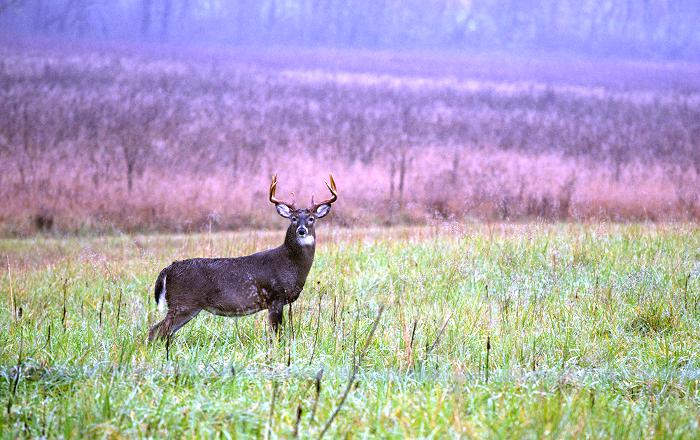
As a fellow deer hunter, I completely understand why hunters would prefer to avoid precipitation. No one wants to get wet and cold, wants their favorite deer rifle or bow to get wet, especially with the feeling that they are wasting time in the woods since they have heard that deer are not active during or after a rainstorm. Or do deer move before or after bad weather?
Let’s take a look at answering the following question: do deer move after rain?
The short answer is yes, they do move right after showers, but let’s dive a little bit deeper into the topic and discuss the how and why rain affects whitetail deer.
However, before we get too far into that topic, I wanted to take a second and point out that, in some respects, deer are like people. By that, I mean that not all deer are alike and have the same temperament.
Some deer are more cautious than others based on prior experiences, close calls with predators, etc. For example, a buck that has been shot at a few times (via rifle, shotgun, or bow) will be far more cautious than a younger buck who hasn’t been shot at yet.
I bring this up to say that how deer react to precipitation is not a universal concept in that all deer respond to rain the exact same way. For example, some deer will move during different levels of precipitation, while other, more experienced whitetails that have been alive a few years may be less likely to move during any rainfall. Precipitation seems to affect deer differently, depending on their individual personalities.
Understanding How Precipitation Affects Whitetail Deer Movement
While deer activity is impacted by rainwater, their behavior seems tied to several different factors associated with the rainfall, including the following:
- Level or severity of the rain
- Duration or length of the rain
- Time of year in the rut cycle
Let’s break each one of those topics down for further discussion.
Level or Severity of the Precipitation
The severity of the rain can and will impact how much deer move in the rain. For classification purposes, I usually break rain severity down into four different categories (based on commonly accepted meteorological definitions):
- Drizzling rain
- Light rainfall
- Moderate rain
- Heavy rain
Let’s go a little bit deeper into each of these rain levels to discuss the effect on deer movement.
Drizzling
A drizzling rainfall is a very light shower where the water drops are tiny (a diameter of fewer than .02 inches). Drizzle is also commonly called misting, and the water drops are so fine that they can only be felt as they contact the skin.
For most deer, drizzling or misting showers are no big deal, so they will follow their typical patterns during this type of weather event.
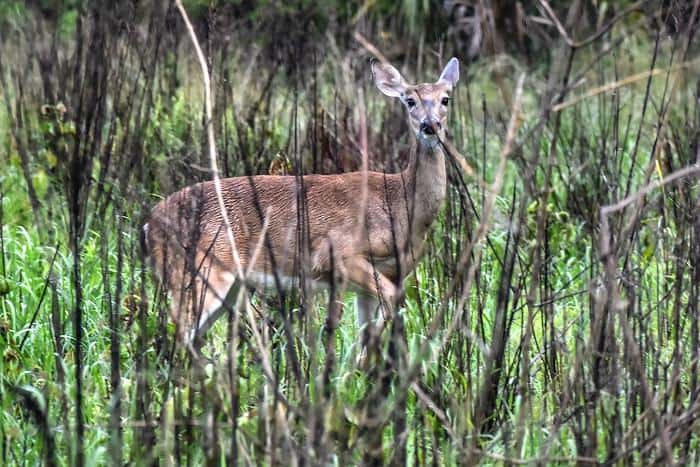
During a drizzle can be an excellent time to hunt as most deer feed and move as usual. The fine raindrops may cause a slight background noise as they hit the ground, but it shouldn’t be enough to compromise a hunter’s ability to hear.
I would definitely consider hunting during a drizzle.
Light Rain
Once you move beyond a drizzle, the meteorological rain classifications are dependent on the amount of rain that falls in an hour. A light rain is classified as .01 inch or less per hour.
While light showers have a higher volume of rain coming down, it’s still not sufficient to bother most whitetail deer, as I see a substantial number moving on camera during light precipitation all the time.
The noise of light steady rain (raindrops hitting trees, the ground, etc.) will begin to adversely impact a hunter’s hearing in the woods, but the deer face the same issue.
The caveat I’ll point out with deer moving under light shower circumstances involves thunder or lightning present with the weather conditions. In those situations, deer seem to bed down and ride the elements out versus continuing to feed.
As long as lighting, thunder, or extremely windy conditions are not present with light drizzle, I would consider hunting whitetail during that rain level.
Moderate Rain
Moderate rain is defined as an accumulation of rainfall within an hour that exceeds .11 to .3 inches.
In my experience, the whitetail movement begins to dwindle during a moderate rain as deer will start to seek cover (usually in something thick) and bed down. The only exception to that rule seems to be the peak of the rut. During peak rut, some bucks will continue moving in moderate rain in an attempt to locate hot does.
Here’s how I typically handle moderate rain:
If I’m in the stand as moderate rain begins, I’ll check the weather patterns to see the expected duration. If the weather report indicates a rain event that will be passing through in less than 2 hours, I’ll generally stay in the stand (especially around dawn or dusk). However, if the shower lasts longer than 2 hours or days, I usually leave the stand and consider a plan B option.
If I wake up to moderate rain and the forecast supports a steady downpour, I’ll usually postpone hunting until just before the rain is expected to stop. In that scenario, I definitely want to be in the woods or in the stand when the rain stops (and I’ll talk more about that below).
Heavy Rain
Heavy rain is defined as an hourly rainfall accumulation exceeding .3 inches per hour. In my experience, deer don’t move at all during heavy rainstorms. Instead, they find some cover and bed down to ride the rain out.
The few times that I have remained in a stand during a heavy downpour, I saw no deer movement at all. In addition, I see no movement on game cameras during a significant rain as well.
I typically won’t try to hunt during a major rain, but I prefer to be in the stand before the rain stops.
Duration or Length of Rain
Another factor that plays a role in deer movement during or after a rain is the duration of the rain.
Deer have to eat a substantial amount of food each day to stay healthy and reproduce. While estimates vary slightly, most deer biologists estimate that deer consume between 5 to 8% of their body weight each day. But, of course, those numbers will vary based on time of year, geographic location, and sex.
So, a healthy doe that weighs 100 pounds will need to consume somewhere between 5 and 8 pounds of food each day.
My point in those numbers is to point out that, under normal circumstances, deer can only go so long without eating.
If it rains heavily for three days straight, the deer affected by that rain has probably eaten very little during those three days and will be on the move as soon as it slacks up.
Time of Year in the Rut Cycle
The rut is the one time of year when typical deer behavior changes drastically for male deer (bucks).
When the rut begins, bucks have a primary biological drive to find female deer (does) that are in estrus and ready to breed.
The rut period also impacts how deer (mostly bucks) deal with the rain. When the rut is in full swing, most bucks will be out trying to find does in all but the absolute worst rainy day conditions.
I’d consider hunting in drizzle, light, and moderate rain during the rut as bucks will be moving. They will move less during a serious rain but will start moving again as soon as the rain slows up or ends.
In periods before and after the rut, the behavior is more predictable regarding how deer react to rain.
Deer Hunting Tactics After a Rainfall
Here are a few tactics that I employ for hunting deer after a rain:
During the Rut
During the rut, I do my best to stay in the stand even in major rain because as soon as the rain stops, bucks will be doing two things:
- Returning to their scraps to freshen them up and cover up the scent of any other buck that has hit the scrape recently.
- Return to cruising for does in heat.
Because of these two behaviors, I do my best to be in the stand and ready before the rain stops. Many hunters make the mistake of waiting until the rain stops to get back in the stand, but I prefer to get back into the woods at least an hour before the rain stops. Even if it means sitting in substantial showers for a bit, it can be well worth the hassle. One of the largest mature bucks I’ve harvested to date was taken immediately after a rain when he responded to some rattling and a grunt call near one of his scrapes.
Non-Rut Hunting
Outside of the rut, here’s my approach for hunting during or right after a rain:
If the major rain has lasted for more than two days, I’ll do my best to be in the woods just before the rainfall stops or slacks off. If the deer have been bedded down during a prolonged rain period for more than 24 hours, they will be hungry and immediately start foraging for food. In my opinion, this is the time to already be in your stand so you can be ready for the movement.
If the rain has been light to moderate for a bit, there will still be some deer who try to feed during the rain (as long as the rain is light), and then there will be other deer who will wait to feed after the rain stops.
An excellent example of this feeding only after a rain behavior occurs with does who are still mothering a yearling deer. While I’ve seen groups of does, single does, and bucks feeding on camera during rain, I’ve yet to catch a doe with a yearling or juvenile deer feeding in the rain on camera (and this data is based on nearly 20 years or so of camera images across multiple hunting properties). I suspect that they fall into the group of deer who prefer to only feed when it’s not raining.
Hunting Whitetail Deer in the Rain
One of the more common questions I hear at my day job is, “should I deer hunt in the rain?”

Choosing to hunt during any rainfall is a personal choice as it’s not for everyone. Not everyone wants to deal with the wet weather, the potentially cold weather, and the wet gear.
Personally, I feel that it can be worthwhile to stay in the woods to hunt in showers as long as the conditions are right and you understand the challenges that come with hunting in wet weather.
I find that hunting during a drizzle, light rain, and mild, medium rain can be productive. However, if the rain is accompanied by heavy winds, constant thunder, or lightning, I usually take a pass.
Another aspect of hunting deer in the rain is having the proper gear along to keep you comfortable and dry.
A few key points to be aware of with hunting in the rain:
- The rain creates noise that reduces the hunter’s hearing with deer. However, it also reduces a deer’s hearing as well.
- Rain can impair a hunter’s vision, especially at longer distances. I suspect it also interferes with the deer’s vision, but I’m not sure that’s ever been scientifically proven.
- Depending on the volume of rain, the impact of the raindrops striking objects like leaves, branches, etc., can create quite a bit of movement in the woods. This additional movement makes hunting via sight more complicated.
- Precipitation like rain or snow also means wet leaves, which will muffle the sound of whitetails moving through the woods.
Although those issues can adversely impact the hunter, they also adversely affect the deer. Hunting in the rain really becomes an exercise in hunting via sight only because the background noise has eliminated the opportunity to hear deer moving through the woods.
Rain Hunting Gear
There are a few pieces of gear that can make hunting in the rain a bit more bearable, and here are a few suggestions:
Tree Stand Umbrella
When the topic of rain gear comes up, most deer hunters immediately think of a raincoat or rain pants to keep you dry. While those two items can be beneficial in the rain, the one that most hunters completely forget is a tree stand umbrella.
There are several tree stand manufacturers that offer an umbrella designed to work with a tree stand and provide shelter from the rain.
While it is another piece of gear that you have to carry into the woods, I very much prefer a tree stand umbrella as my first line of defense against the rain because I find that I can hear better while under the umbrella versus having my head covered with the hood of a rain jacket.
There are several good tree stand umbrellas on the market, but here are my two favorite models:
Rain Suit or Rain Jacket
At an absolute minimum, hunting any game species in the rain or in rainy weather will require some kind of waterproof clothing.
For most hunters, that piece of clothing is a jacket. Hunting rain jackets generally fall into two categories:
- An existing mid-weather to cold weather jacket that is already waterproof and works to repel the rain.
- A lightweight rain jacket that is dedicated only for rain use.
While I have a few jackets of both types, my personal preference is a lightweight rain jacket (and pants, where applicable) that are packable and easy to carry. I carry a jacket and rain pants set that comes in a single bag and is easy to carry in my hunting pack.
I find the packable rain jacket and pants to be the best option for me because they are small and lightweight enough for easy transport, quick to deploy when needed, and easy to pack up when the rain stops.
When it comes to hunting jackets and rain jackets in general, you could look at the well-known and pricey brands like Sitka or Kuiu, but those brands charge a premium price. While the top-tier brands are good, I also have had very good luck with some of the less expensive brands, including the following:
Firearm or Bow Protection
For some hunters, letting their rifle, shotgun, or bow get wet is no big deal, but it can be a huge deal for others. Typically speaking, water and firearms are not a good mix, so most hunters take one of three potential approaches:
- Let the firearm or bow get wet, then clean it when they arrive home.
- Find a way to keep the firearm or bow covered as much as possible and then clean if needed.
- This next point is more for firearms. Coat the firearm in an aftermarket finish that is more durable than traditional blued steel that is more resistant to water. A great example is Duracote or Cerakote. Those finishes are far more weather resistant than an unfinished firearm and will require less post-hunt cleaning.
I tend to lean towards options number two and number three. I try to keep a non-weatherized firearm as covered as possible and clean if needed. I also own a few deer rifles that are specifically designated as “bad weather” rifles as they have been completely Cerakoted and utilize polymer stocks.
Hopefully, the information presented above helps determine if hunting deer right after rain is worth the effort. My answer has always been a resounding yes, but it may not be for everyone.
FAQS
Here are some frequently asked questions that are commonly associated with deer hunting after a rain:
Is it worth hunting right after a rain?
I’ve always felt that hunting right after rain was worthwhile, especially if it has been a light to moderate rain. Rain can wash away human scent and make it more difficult for deer to detect your presence, increasing your chances of a successful hunt.
How does rain affect deer movement?
Rain can affect deer movement in several ways. It may cause deer to seek shelter and bed down until the rain stops. However, once the rain subsides, deer may become more active as they search for food sources that have been washed out or uncovered by the rain.
Do deer tend to move before or after a rain?
I’ve always suspected that there was some deer movement before and after a rain. Whitetails seem to move before rain, especially if they sense a change in the weather. They may increase their foraging activity to build up energy reserves before the rain arrives. After the rain, deer may move to take advantage of freshly exposed food sources.
Can deer sense the approaching rain?
Deer can sense changes in barometric pressure and may become more active as a storm approaches. They have a keen sense of smell and can detect the moisture and scent of rain in the air. This can sometimes translate into increased deer movement before a rain event.
Are deer more likely to move around during or after a rain?
Deer are more likely to move around after a rain, especially if the rain has subsided and the weather conditions are favorable. They may be more active during periods of damp or wet weather when there is less hunting pressure, and their movement can go unnoticed.
Should I quit hunting if it’s raining heavily?
I’ve always felt that hunting in heavy rain was challenging and may not be worth the effort. Deer will likely avoid open areas and seek shelter in thick cover, making it difficult to spot and approach them. It is advisable to wait for the rain to subside or hunt during lighter rain showers for better chances of success.
Will deer still move during a light rain?
In my experience, deer can still move during a light rain. While they may be more cautious and prefer areas with cover, they will continue searching for food sources and going about their normal activities, albeit with more caution.

Born and raised in Indiana, Brantley spent his youth chasing deer and turkey and, along the way, developed a passion for bowhunting. Although he still enjoys other types of hunting, his true passion is bowhunting, and he has or will author most all the bowhunting content on this site. Outside of work, Brantley is married and the father of two beautiful little girls. Brantley has worked in the hunting industry, with an emphasis on archery and bowhunting, for more than ten years.






